Electronic Component Description Output
Torque Converter Clutch (TCC) Solenoid
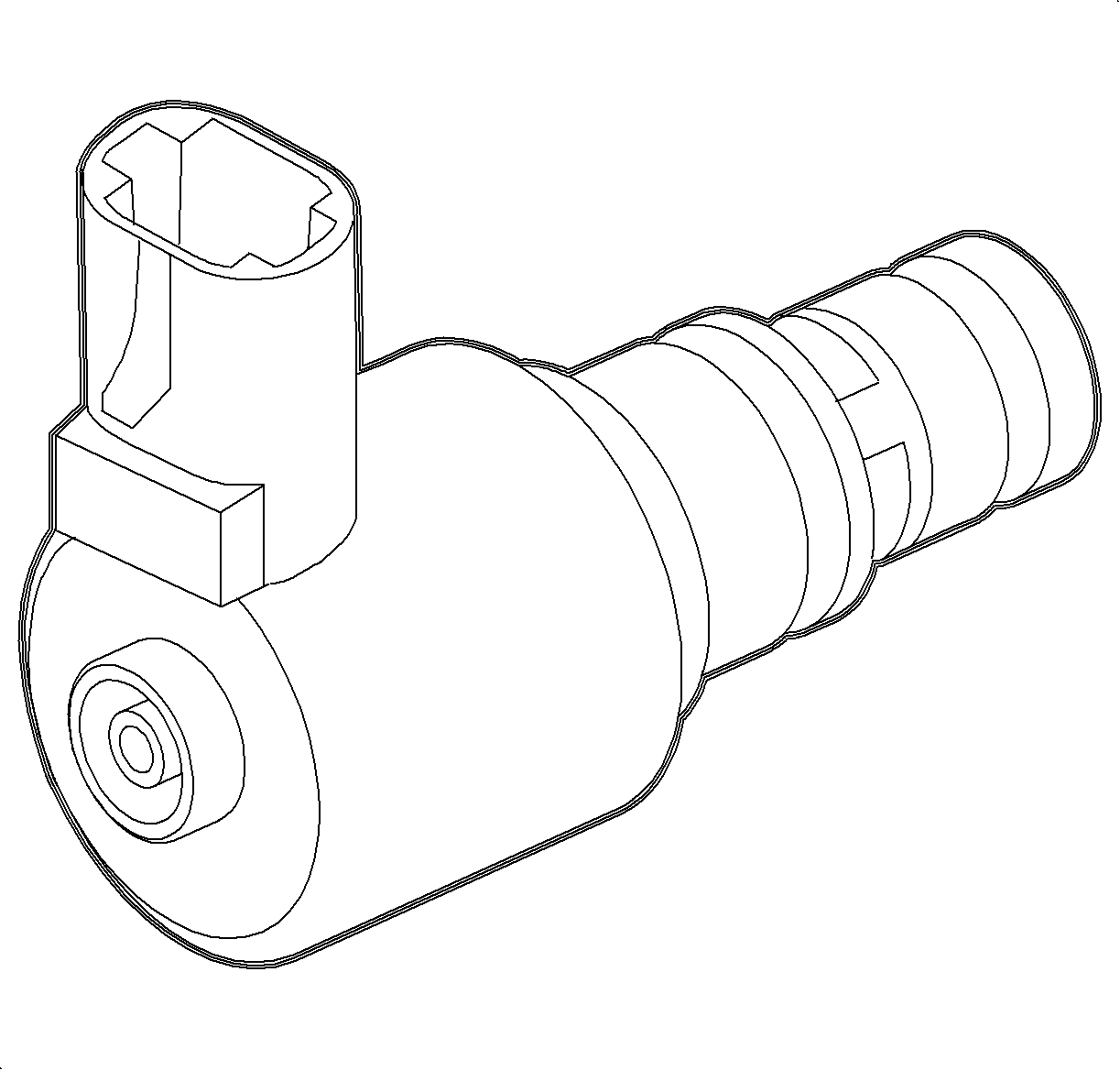
The torque converter clutch (TCC) solenoid is a normally closed, pulse width modulated (PWM) solenoid used to control apply and release of the torque converter clutch (TCC). The PCM/TCM operates the solenoid with a negative duty cycle at a fixed frequency of 42 Hz to control the rate of TCC apply/release. The solenoid's ability to ramp TCC apply and release pressures results in a smoother TCC operation.
When vehicle operating conditions are appropriate to apply TCC, the PCM/TCM immediately increases duty cycle to approximately 68%. The PCM/TCM then ramps duty cycle up to approximately 93% to achieve full TCC apply pressure. The rate at which the PCM/TCM increases duty cycle controls TCC apply. Similarly, the PCM/TCM also ramps down TCC solenoid duty cycle to control TCC release.
Some operating conditions prevent or enable the TCC apply under various conditions. Also, if the PCM/TCM receives a high voltage signal from the brake switch indicating that brake pedal is depressed, the PCM/TCM immediately releases the TCC.
The TCC solenoid resistance should measure between 10-11 ohms when measured at 20°C (68°F). The resistance would measure approximately 16 ohms at 150°C (300°F).
Pressure Control Solenoid
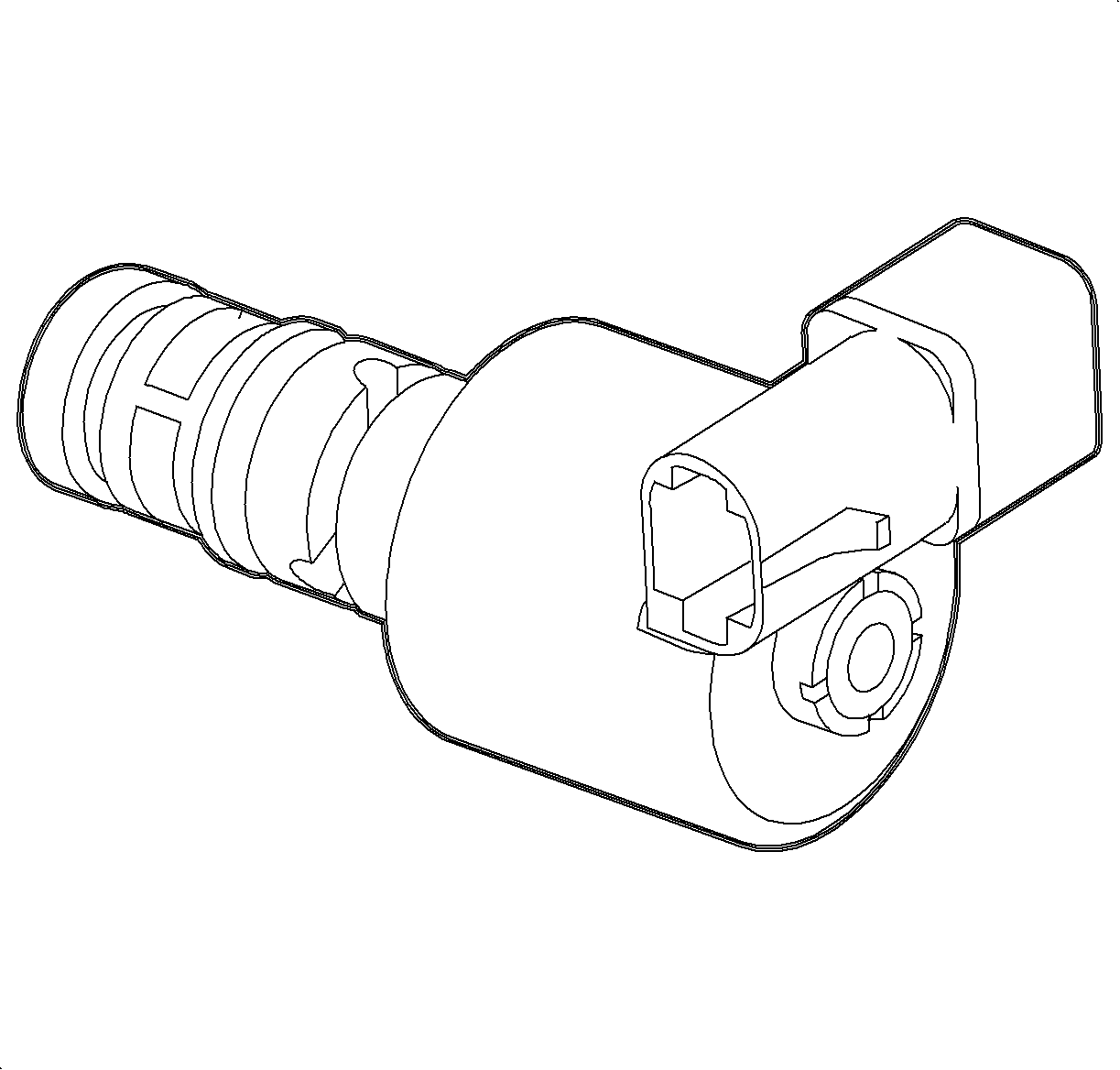
The pressure control (PC) solenoid is a precision electronic pressure regulator that controls transaxle line pressure. This control is based on flow of current through solenoid coil windings. As the flow of current is increased, the magnetic field which is produced by the coil moves the solenoid's plunger further away from the exhaust port. Opening the exhaust port decreases output fluid pressure regulated by the PC solenoid, which ultimately decreases line pressure.
The powertrain control module (PCM) or transaxle control module (TCM) controls the PC solenoid based on various inputs, including throttle position, transaxle fluid temperature, MAP, and gear state.
The PCM/TCM controls the PC solenoid on a positive duty cycle at a fixed frequency of 614 Hz. Duty cycle is defined as percent of time current is flowing through the solenoid coil during each cycle. A higher duty cycle provides a greater current flow through the solenoid. The high (positive) side of the PC solenoid electrical circuit at the PCM/TCM controls PC solenoid operation. The PCM/TCM provides a ground path. The PCM/TCM monitors average current and continuously varies the PC solenoid duty cycle to maintain the correct average current flow.
Duty Cycle | Current | Line Pressure |
|---|---|---|
+5% | 0.02 amps | Maximum |
+40% | 1.1 amps | Minimum |
The resistance of the PC solenoid should measure between 3-5 ohms at 20°C (68°F).
Shift Solenoid: 1-2 and 2-3
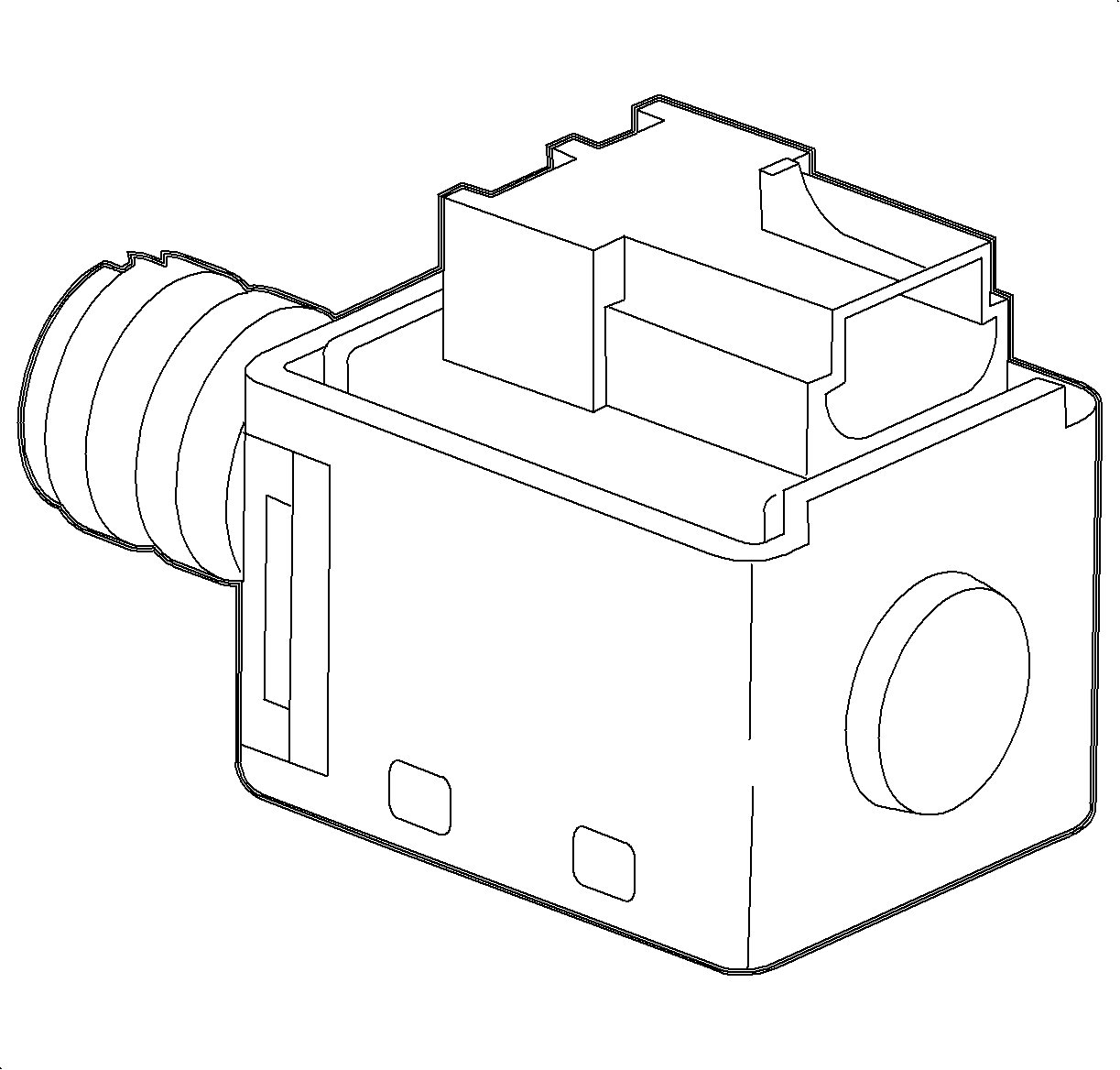
Shift solenoids are two identical, electrical exhaust valves that control upshifts and downshifts in all forward gear ranges. These valves are normally open. These shift solenoids work together in a combination of ON and OFF sequences in order to control positions of 1-2, 2-3 and 3-4 shift valve trains. The PCM/TCM monitors numerous inputs to determine the appropriate solenoid state combination and transaxle gear for the vehicle operating conditions.
Gear | Solenoid 1-2 | Solenoid 2-3 |
|---|---|---|
Park, Reverse, Neutral | ON | OFF |
First | ON | OFF |
Second | OFF | OFF |
Third | OFF | ON |
Fourth | ON | ON |
Important: The solenoid states are normally ON (1-2) and OFF (2-3) in the P, R, and N gears. However, these may change based on the vehicle speed and throttle position.
The PCM/TCM energizes the shift solenoid by providing a ground to the solenoid's electrical circuit. This sends current through the coil winding of the solenoid, thereby creating a magnetic field. The magnetic field repels the plunger inside the solenoid. This seats the solenoid metering ball against the fluid inlet port. This action provides an increase in fluid pressure at end of shift valves. This fluid pressure initiates an upshift by moving the shift valves. The resistance of the shift solenoids should measure between 19-24 ohms when measured at 20°C (68°F) and between 24-31 ohms when measured at 88°C (190°F). The shift solenoid should energize when voltage is greater than 7.5 volts and de-energize when voltage is less than 1 volt.
Oil Level Control Valve
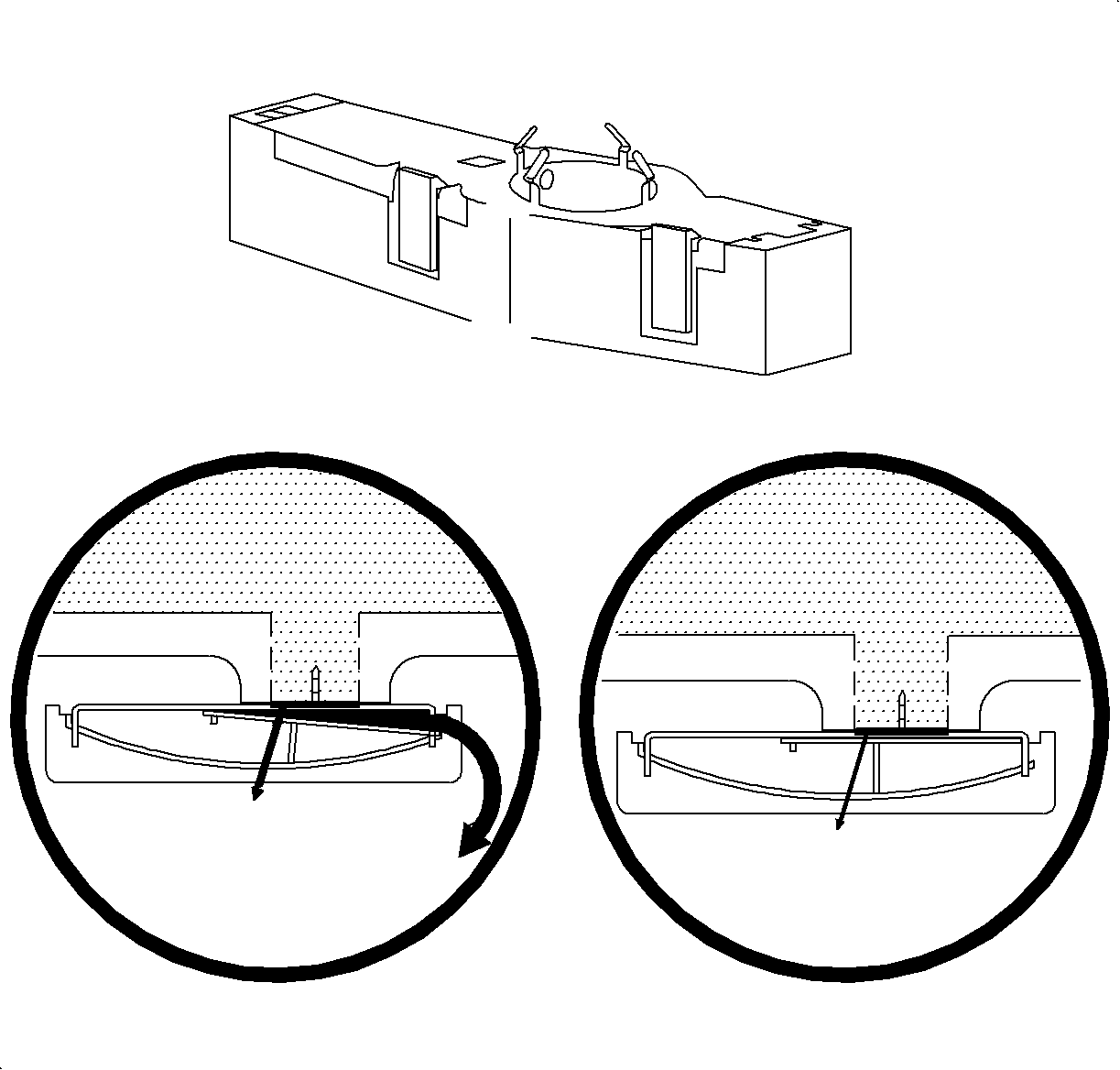
The oil level control valve is located on the bottom of the case next to the fluid filter, and is designed to control the fluid level in the side cover. At low temperatures, the thermostatic element exerts little pressure on the thermostatic element plate allowing fluid to drain into the sump (left balloon). As the temperature of the fluid increases, the thermostatic element begins to apply pressure to the thermostatic element plate, thereby trapping fluid in the side cover (right balloon). This level of transaxle fluid is required in order to maintain the operation of the hydraulic system in the transaxle.
It should be noted that when checking the fluid level, it will be higher when the transaxle is cold. Conversely, the fluid level will drop when checked at operating temperatures. Thus, the fluid level of the transaxle must be checked when the fluid is at operating temperature.
Electronic Component Description Input
| Table 1: | TFT Sensor - Temperature-To-Resistance |
| Table 2: | TFP Switch Chart |
Transmission Control Module (TCM)
The TCM is mounted in the passenger compartment and connects directly to the wiring harness. Two connectors are used to make connections between the vehicle wiring, the transmission, and the TCM. The TCM is an electronic control module that receives input and provides output to control the operation of the 4T45-E automatic transmission.
The TCM receives the following inputs from the engine control module (ECM):
| • | Engine speed and torque values |
| • | Engine intake air temperature (IAT), and throttle position (TP) information |
| • | Engine coolant temperature (ECT) |
| • | Air-conditioning (A/C) status |
| • | Cruise control status |
The ECM provides this data to the TCM through the Keyword Serial Data. A two-wire circuit is used to communicate data between the ECM and TCM. Other TCM inputs are the following:
| • | Battery and ignition voltage |
| • | Brake switch status |
| • | Transmission fluid temperature (TFT) |
| • | Transmission input speed sensor (ISS) |
| • | Transmission output speed sensor (OSS) |
The TCM provides the following outputs in order to control the automatic transmission:
| • | Line pressure control solenoid (PCS) valve regulates the transmission line pressure |
| • | The torque converter clutch (TCC) enable solenoid valve is used to hydraulically select whether the TCC pressure control solenoid valve will control the fluid pressure used to apply the forward and reverse clutches or the fluid pressure used to apply the torque converter clutch |
| • | TCC pressure control solenoid valve is used to control the fluid pressure used to apply and release the forward and reverse clutches, and the torque converter clutch |
Other TCM outputs provided to the ECM are the following:
| • | MIL illumination request |
| • | Vehicle speed |
| • | Transmission input speed |
| • | Transmission fluid temperature |
| • | TCC status |
| • | Torque reduction requests |
| • | Park/Neutral Position Assembly status |
| • | Transmission service status |
Stop Lamp Switch
The stop lamp switch operates vehicle stop lamps and signals several electronic modules on vehicle, including the TCM. The switch is normally open when the brake pedal is in released position. When the brake pedal is depressed, pressure on the switch plunger is released and the switch closes. If TCC is engaged when brake pedal is depressed, the TCM will disengage TCC.
Transaxle Fluid Temperature (TFT) Sensor
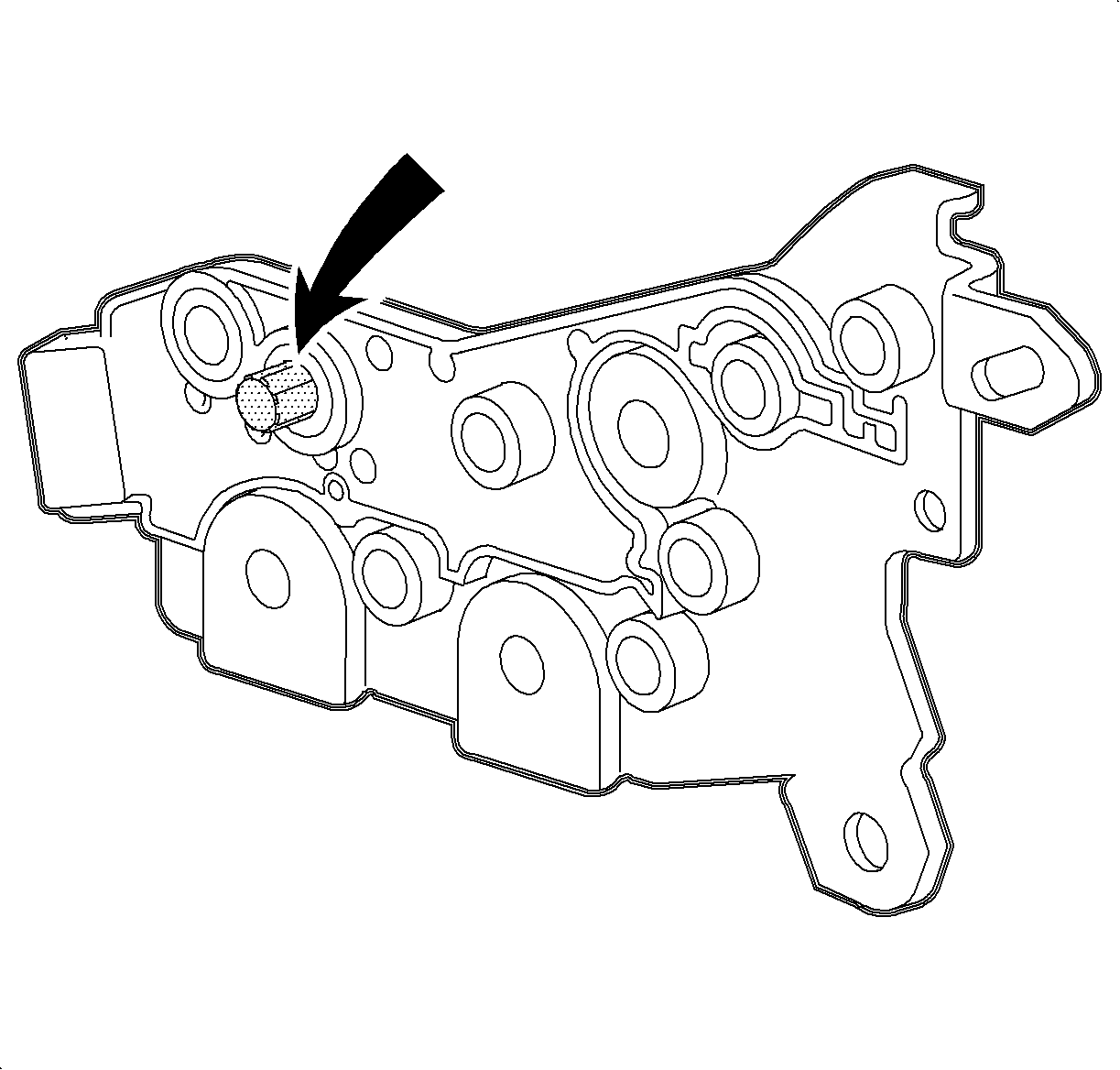
The transaxle fluid temperature (TFT) sensor is a negative temperature coefficient thermistor that provides information to the TCM regarding transaxle fluid temperature. The temperature sensor is integrated in transaxle fluid pressure switch assembly which is bolted to the control valve body. The sensor monitors main line pressure from the inside of the control valve body in order to determine the operating temperature of the transaxle fluid. The sensor uses an O-ring seal to maintain fluid pressure in the control valve body.
The internal electrical resistance of the sensor varies in relation to the operating temperature of the transaxle fluid. The TCM sends a 5-volt reference signal to the temperature sensor, then measures voltage drop in the electrical circuit. A lower fluid temperature creates a higher resistance in the temperature sensor, thereby measuring a higher voltage signal.
The TCM measures this voltage as another input to help control line pressure, shift schedules and TCC apply. When the TFT reaches 140°C (284°F), the TCM enters hot mode. Above this temperature the TCM modifies the transaxle shift schedules and TCC apply in an attempt to reduce fluid temperature by reducing the amount of heat generated by the transaxle. During hot mode the TCM applies TCC at all times in Third and Fourth gears. Also, the TCM performs the 2-3 and 3-4 shifts earlier in order to help reduce heat generated in transaxle fluid.
°C (°F) | R Low (ohms) | R High (ohms) |
|---|---|---|
0°C ( 32°F) | 7987 | 10859 |
10°C (50 °F) | 4934 | 6407 |
20°C (68 °F) | 3106 | 3923 |
30°C (86 °F) | 1991 | 2483 |
40°C (104 °F) | 1307 | 1611 |
50°C (122 °F) | 878 | 1067 |
60°C (140 °F) | 605 | 728 |
70°C (158 °F) | 425 | 507 |
80°C (176 °F) | 304 | 359 |
90°C (194 °F) | 221 | 259 |
100°C (212 °F) | 163 | 190 |
Output Speed Sensor (OSS)
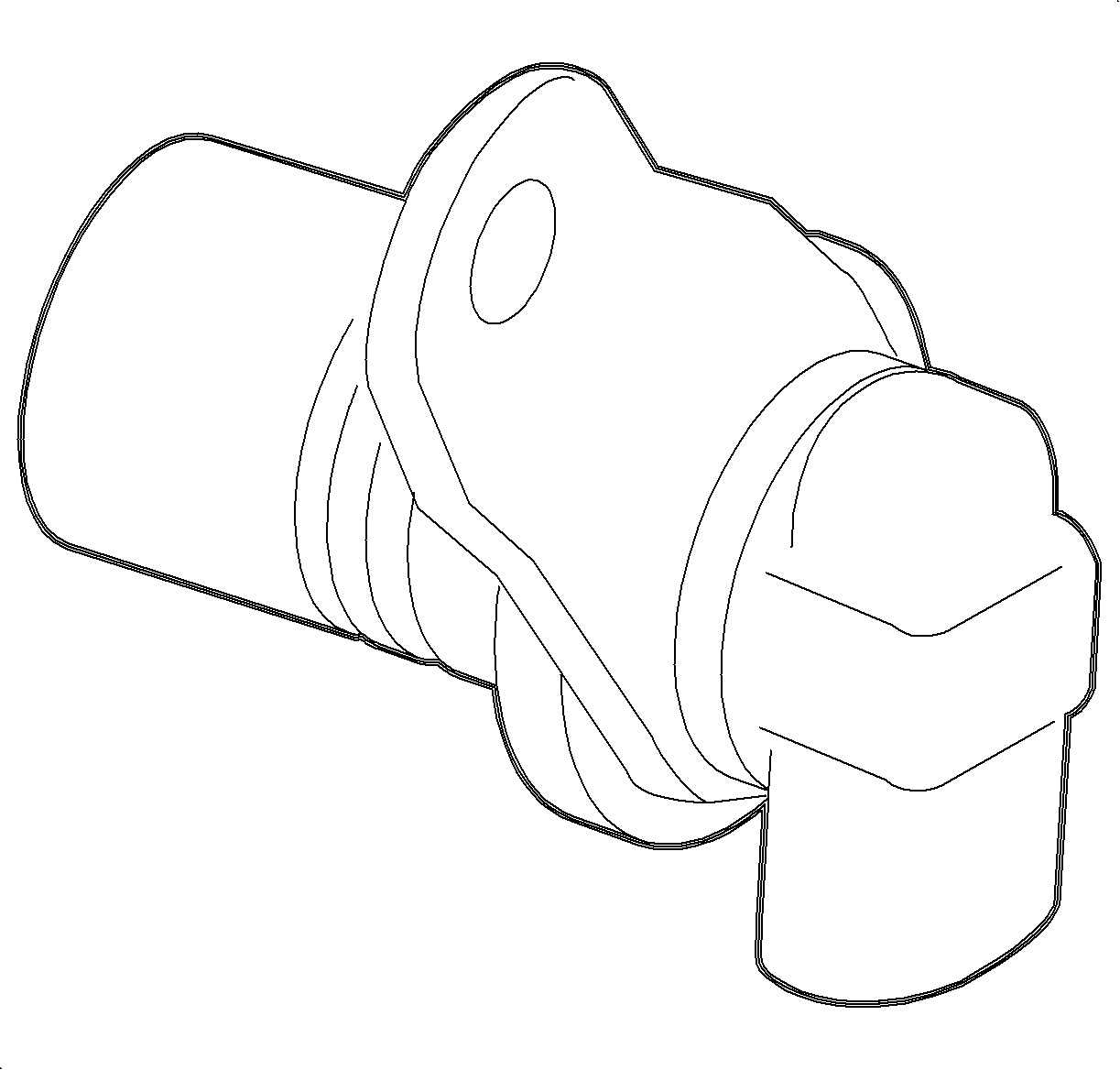
The output speed sensor (OSS) is a magnetic inductive pickup that relays information relative to vehicle speed to the TCM. Vehicle speed information is used by the TCM to control shift timing, line pressure, and TCC apply and release.
The OSS mounts in transaxle case near the speed sensor rotor which is pressed onto final drive assembly. An air gap of 0.27-1.57 mm (0.011-0.062 in) is maintained between sensor and teeth on the output shaft speed sensor rotor. The sensor consists of a permanent magnet surrounded by a coil of wire. As the differential rotates, an AC signal is induced in the OSS. Higher vehicle speeds induce a higher frequency and voltage measurement at sensor.
Sensor resistance should be 1500 ohms when measured at 20°C (68°F). Output voltage will vary with speed from a minimum of 0.5 volts AC at 25 RPM to 200 volts AC at 1728 RPM.
Input Speed Sensor (ISS)

The input speed sensor (ISS) is a magnetic inductive pickup that relays information about the transaxle input speed to the TCM. The TCM uses this information to control line pressure, TCC apply and release, and transaxle shift patterns. This information is also used to calculate appropriate operating gear ratios and TCC slippage.
The ISS mounts on the transaxle case under the channel plate next to the drive sprocket. An air gap of 0.26-2.90 mm (0.010-0.114 in.) is maintained between the sensor and teeth of drive sprocket. The sensor consists of a permanent magnet surrounded by a coil of wire. As the drive sprocket is driven by the turbine shaft, an AC signal is induced in the ISS. Higher vehicle speeds induce a higher frequency and voltage measurement at the sensor.
Sensor resistance should be 625-725 ohms when measured at 20°C (68°F). Output voltage will vary with speed from a minimum of 0.5 volts AC at 550 RPM, to 200 volts AC at 7000 RPM.
Transaxle Fluid Pressure (TFP) Switch Assembly

The transaxle fluid pressure (TFP) switch assembly is attached to the control valve body. This assembly contains three fluid pressure switches and the transaxle fluid temperature (TFT) sensor.
Two of the fluid pressure switches are normally open. These are used to indicate the position of the manual valve. The TCM uses this information to control line pressure, TCC apply and release and shift solenoid operation.
The TCC pressure release switch is used as a diagnostic tool to confirm that TCC is actually OFF when it has been commanded OFF by TCM. This switch is normally closed.
Each fluid pressure switch produces either an open or a ground to the TCM depending on the presence of fluid pressure at switches. The sequence of open and closed switches produces a combination of voltage readings. The TCM monitors these readings.
The TCM measures TFP switch signal voltage from each pin to ground and compares voltage to a TFP switch combination table stored in TCM memory. If TCM does not recognize TFP switch sequence, a diagnostic code will be set as a result. A diagnostic code may also set if the TFP switch sequence indicates a gear range selection that conflicts with other sensor inputs to the TCM.
Range Indicator | Fluid Pressure | Circuit | ||||||||||
|---|---|---|---|---|---|---|---|---|---|---|---|---|
REV | DR | B (1225) | C (1226) | |||||||||
Park/Neutral | 0 | 0 | OFF | OFF | ||||||||
Reverse | 1 | 0 | OFF | ON | ||||||||
Overdrive | 0 | 1 | ON | OFF | ||||||||
Manual Third | 0 | 1 | ON | OFF | ||||||||
Manual Second | 0 | 1 | ON | OFF | ||||||||
Manual First | 0 | 1 | ON | OFF | ||||||||
| ||||||||||||
Valid combinations for circuits B (1225) and C (1226) are shown in table. ON means that the switch is grounded with a resistance less than 50 ohms at 0 volts; OFF means that switch is open with a resistance greater than 50 K ohms at 12 volts.
Park/Neutral Position (PNP) Switch
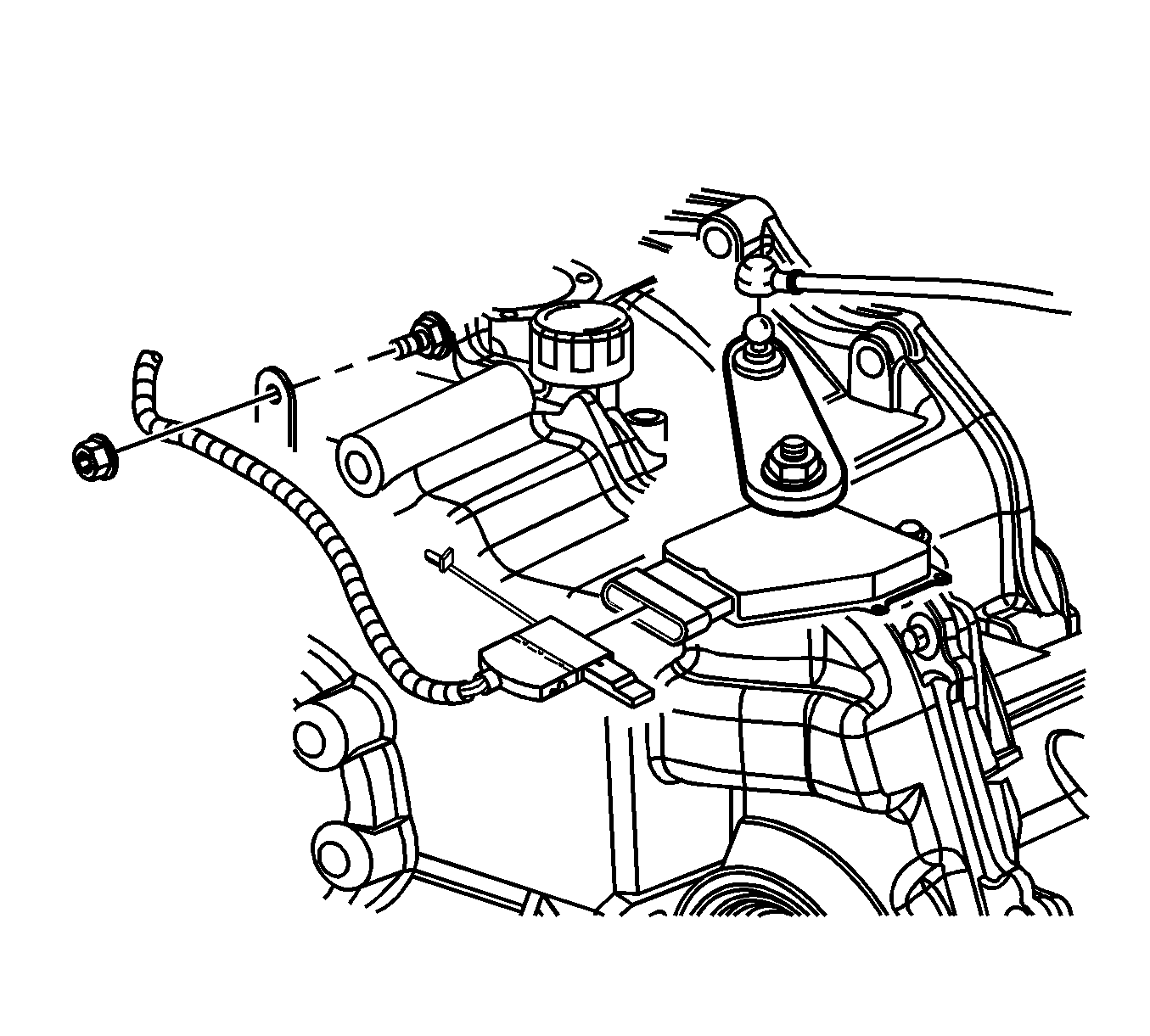
The PNP switch is located on top of the transaxle. The transaxle range switch contains multiple switches, four of which are used to create a coded signal to the TCM indicating gear selection. The coded signal can be viewed on the Scan tool as TR Switch - P/A/B/C and gear position indicated can be viewed as transaxle Range. The different combinations of the four TCM inputs, P/A/B/C, represent selections from Park to 1st or Invalid/Grounded/Open. Refer to table below.
On a vehicle equipped with a 2.2L, switches are all attached to ground on one side. When the switch closes, the PCM input is pulled low (ON). When switch is open input reads high (OFF). On vehicles equipped with a 3.0L, all switches are connected to ignition voltage on one side. When the switch closes, the TCM input is pulled high (ON). When switch is open the input reads low (OFF).
Gear Selector Position | TR Switch - P/A/B/C Displayed On Scan Tool | |||
|---|---|---|---|---|
P | A | B | C | |
Park (P) | ON | ON | OFF | OFF |
Reverse (R) | OFF | ON | ON | OFF |
Neutral (N) | ON | OFF | ON | OFF |
Drive (D) | OFF | OFF | ON | ON |
Third (3) | ON | ON | ON | ON |
Second (2) | OFF | ON | OFF | ON |
First (1) | ON | OFF | OFF | ON |
